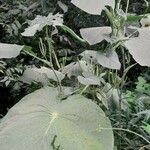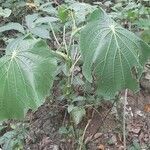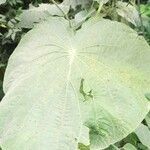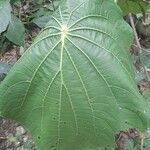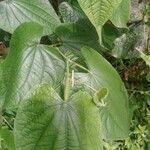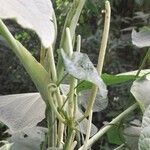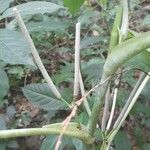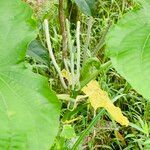Large herb to 3 m tall. Internodes black glandular-dotted, more densely so on nodes. Leaves alternate, peltate; petiole attached at up to 1/3 of blade, rarely near base, 8-20 cm long, vaginate or slightly winged in lower part; blade glandular-dotted, round-ovate, to 16-30 x 18-40 cm, apex acute, base nearly rounded to usually deeply cordate, glabrous except for short hairs on veins; palmately 13-15-veined, veins radiating from petiole tip, and 2 pairs originating from central vein. Inflorescence erect, umbellate, seem to be axillary, but are reduced, sympodial branches with very short internodes, without leaves; common peduncle 2-8 cm long, peduncles slender, 1-1.5 cm long; spikes numerous, 5-10 cm long, each subtended by a single prophyll, densely flowered; floral bracts marginally fringed. Fruits trigonous, glabrous.
An erect shrub. It has a few branches. It can grow to 2.5 m tall. The stems are cylinder shaped and tapering and with a white powder on the surface. They are swollen at the nodes. The leaves are alternate and have long leaf stalks. They are broadly heart shaped and the leaf stalk joins away from the edge of the leaf. They taper to a short tip. They are a pale green above and whitish underneath. They are 15-50 cm across. The leaf stalk forms a sheath at the base. The flowering shoots occur singly in the axils of the leaves and develop as 7-32 spikes. The fruit are small berries with gland dots over them.
